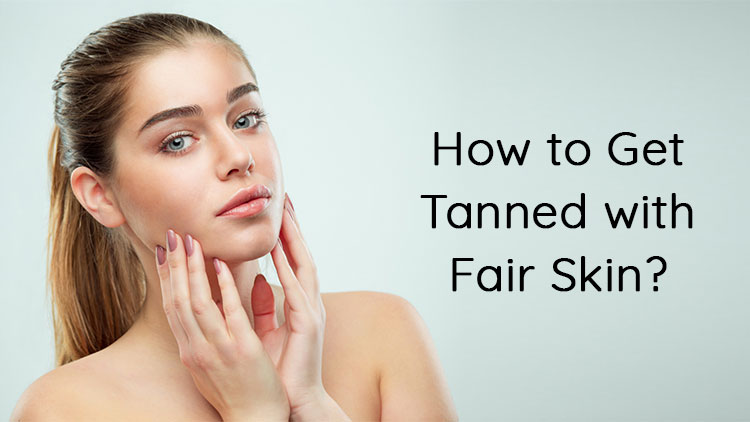Fair skin is a human skin color that is usually considered the lightest natural shade, typically associated with people of Caucasian or East Asian descent. However, this skin tone can occur in people from various racial and ethnic backgrounds due to global migration and genetic spread. It’s believed to have originated in people living in Northern Europe and Northeastern Asia, where the sun’s rays aren’t as strong.
Fair skin comes in a variety of tones and shades, but generally speaking, “fair” skin is just as prone to dryness, oiliness, and breakouts as any other skin type. Despite the external color, all skin types need to be cared for properly in order to stay healthy.
How Fair Skin Evolved Based on According to Geography and Evolutionary Background?
Cultures from Europe and Asia have long been associated with a fair complexion—and for good reason. Scientists believe that this phenomenon is tied to the amount of sunlight in these regions; the weaker sunlight in certain zones may have encouraged the natural selection of lighter skin, since the body didn’t need to expend as much energy to protect itself from radiation.
But exactly how fair skin evolved is still highly debated. Some believe that it was due to a change in the diet of migrating populations, while others argue that the relative strength or weakness of the sun was the key factor. It makes sense that lighter skinned mutations could more easily survive and repeat in areas with weaker sunlight, such as the poles.
This video explains this point very well –
No matter the origin, fair skin has become an important component of many cultures, both in Europe and Asia.
How Sun Damages the Fair Skin?
One of the biggest risks of having fair skin is sun damage. The sun emits ultraviolet (UV) radiation that can damage the skin’s structures and cause sunburn, premature aging, and skin cancer. Fair skin is especially vulnerable to the effects of the sun since it contains less melanin, the pigment that provides sun protection. Even brief exposures to the sun can cause damage, so it’s important to take precautions to protect your skin.
The skin acts as the body’s first line of defense against external elements, but this also makes it one of the most vulnerable. People with fair or very light skin typically have the lowest natural defenses against the sun’s ultraviolet rays and other environmental damage. This means that their skin is more prone to sunburns, often more quickly and more severely than other skin types.
Why and How to Protect Your Skin from the Sun Damage?
In order to protect fair skin from the damages caused by harmful sun rays, it is important to limit exposure to the sun and wear protective clothing, hats, and sunglasses. You should also use sunscreen with an SPF of 30 or higher and reapply it every two hours. Additionally, avoid tanning beds, which can cause skin cancer, premature aging, and other long-term consequences. If possible avoid going out in the sun and manage your outdoor duties in the morning or evening hours when the sun rays are mild.
For people with very pale skin, dermatologists and skin care experts recommend taking extra precautions to protect against sun exposure. Sunscreen should be worn daily to help prevent skin roughness, dark splotches, and wrinkles, which can occur sooner and be more apparent in those with pale skin. Additionally, the risk of sunburns is higher and the damage can be more severe. Take the necessary steps to protect your skin and prevent any long-term damage.
Variations in the Fair Skin Tone
There are a wide variety of skin tones, each with its own unique characteristics. For some people, the presence of blood vessels near the surface of the skin can give a rosy tint, while others may have a lot of freckles and some may have a clear, consistent complexion with cooler undertones. No matter what your skin tone is, it’s important to remember that everyone is beautiful in their own unique way.
Fair complexions can be divided into three distinct groups. Group one is characterized by pale skin with few or no freckles, and green or blue eyes. Exposure to the sun can cause group one individuals’ skin to burn, and then peel. Women with a fair complexion and red hair are sometimes referred to as having an English rose complexion.
But anyone can have this type of skin; fair skinned individuals with an Asian background typically have darker hair, and though freckles are less common, they can still appear. Regardless of ethnic background, fair complexions are unique and beautiful!
Group two individuals have light skin, usually blue eyes, and either brown or blonde hair. Unlike group one, those in this group typically have the ability to tan slightly, though they may still experience sunburn and peeling of the skin. Protective measures such as sunscreen and protective clothing should be taken to avoid sun damage.
The third group includes individuals with light skin, brown eyes, and dark hair. They are less likely to burn and more likely to tan in sunlight due to their unique combination of traits. Their skin type is especially suited for outdoor activities and soaking up the sun’s rays, making them ideal for outdoor enthusiasts.
What Skin Types are Mostly Impacted?
Having “fair skin” is often equated to having a certain complexion, without consideration for the actual skin type. But what many people don’t realize is that people with fair complexions can have skin that is oily, prone to breakouts, or dry – just like any other skin tone. In the majority of cases, “fair” refers only to the pigmentation of skin, and does not change the way it functions.
Fair Skin vs Light Skin : A Comparison
When figuring out the color and tone of your skin, it’s important to understand two main factors: the primary surface color and the underlying skin tone. Your primary surface color is the color you see when you look in the mirror. The underlying skin tone is the shade beneath the surface color, which can be either cool, warm, or neutral. Knowing both of these factors can help you find a makeup and skincare routine that work perfectly for your unique complexion.
Fair Skin
Fair skin is the lightest natural shade of skin color, usually found in people of East Asian or Caucasian descent. However, due to globalisation and travel, fair skin can now be seen in people from all around the world. Whether you have naturally fair skin or you’ve achieved it through tanning, it’s important to look after it with SPF protection and moisturisers.
If you have a fair complexion, you can expect certain characteristics. Ashen skin, and a lack of freckles if you have brown or blonde hair, is common for those with fair complexions. Red-heads, however, are the exception. If you come across a red-head with fair skin, chances are they have either no freckles at all, or a face full of them.
Fair-skinned people tend to have an array of undertones ranging from cool to warm and neutral, including pinks, greens, yellows and blues. The most common undertones for those with fair skin are pink and blue. Choosing a foundation, blush, or other makeup products that complement your natural undertones can help you achieve a flawless look.
Those with very fair skin are particularly prone to having blue or green eyes with a lighter pigment than those with darker complexions. Unfortunately, their light eyes make them extremely susceptible to the powerful rays of the sun, which can lead to painful sunburns and peeling. If you see a fair-skinned person out in the sunshine, it’s important to offer them a pair of sunglasses and some SPF protection. Not only can this help protect their eyes from the harsh UV rays, but it can also reduce their risk of getting painful sunburns and then having to deal with the discomfort of peeling skin afterwards. Remember, those with fair skin don’t tan – they just shift between painful pink and fair, so be mindful of their sun exposure and offer them protection when needed.
Light Skin
Light skin is just a shade darker than fair skin, but is still considered part of the same skin tone family. People of diverse backgrounds and cultures can have light skin. Although it is not as sensitive as fair skin, it still requires care and protection from the sun. Those with light skin should take precautions to protect their skin from UV rays.
People with light skin typically have blue or brown eyes and blonde or brown hair, but they can also have unique combinations of skin traits. While fair-skinned people have lighter eyes, those with light skin tend to have darker eyes, and red hair is rarely seen in this population. Green eyes are an unusual but possible trait in those with light skin, and they are distinguished by cool, warm, and neutral undertones that range from pinks and greens to yellows and blues. Light-skinned people generally have green and yellow undertones.
No matter their skin type, those with light skin can still be susceptible to burning in the sun. Depending on the underlying skin tones, some may tan or not, and some may peel.
It’s important to note that the terms ‘light skin’ and ‘fair skin’ are often used interchangeably, but in the United States, ‘light skin’ generally refers to a person of color with a lighter complexion. This definition differs from the formal definition of ‘light skin’ in reference to complexion.
How To Get Fair Skin?
Typically, fair skin is something you are born with. However, your skin’s complexion is not the same as its condition. Fair skin is prone to damage from the sun, acne scars, and hyper-pigmentation. To protect your skin from sun damage and unwanted pigmentation, use a higher SPF sunscreen and wear sunhats when going out into the sun. Additionally, exfoliating regularly will help new cells regenerate, keeping your skin looking fresh and rosy. If you are looking for ways to lighten your skin, there are some methods of skin bleaching available, but they may have negative side effects on your skin.
How To Tan With Fair Skin?
Unfortunately, the bronze beauties that you see roaming the beaches were never fair-skinned to begin with. Fair skin does not tan very well due to its inability to produce the necessary levels of melanin needed to achieve a golden brown complexion. Fortunately, some people have had positive results with tanning drops and bronzing lotions that can brighten fair skin without the sun’s rays. With the right product, you can still get that sun-kissed glow without the damaging effects of the sun.



















I really enjoyed reading your post. It was well-written and engaging